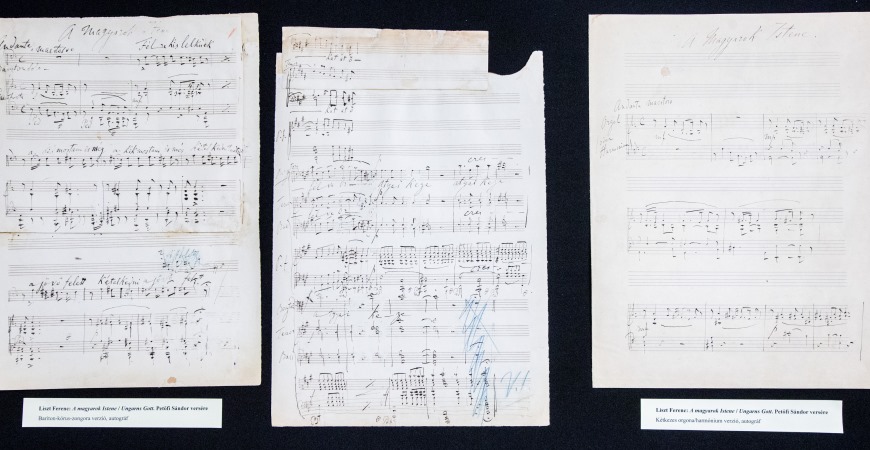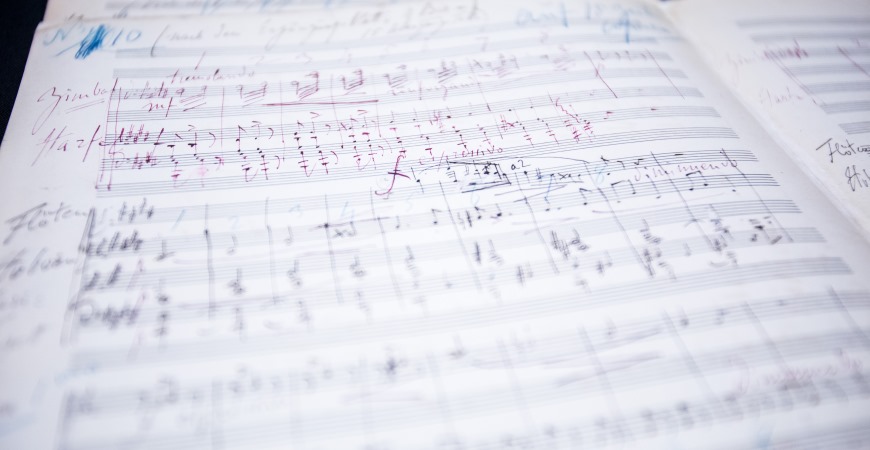Hungary-related handwritten musical notes found their home in the Liszt Museum
Liszt manuscripts believed to be lost have emerged from a private collection. Their historical significance and their impact on Hungarian music-culture is invaluable. The manuscripts purchased by the Liszt Academy with the kind support of the Ministry of Human Resources will come into the guardianship of the Liszt Ferenc Memorial Museum and Research Centre.
The handwritten scores in the bequest was found by one of its heirs, and after having subjected the material to analysis in order to establish its originality, she offered for sale it to the Liszt Ferenc Memorial Museum – which operates within the framework of the Liszt Academy –. The purchase of these documents representing a unique national treasure was enabled by the non-repayable grant of the National Cultural Fund of Hungary. It makes the manuscripts immensely special that they are related to Hungary, Hungarian history, the Hungarian Revolution and War of Independence in 1848/49, thus this date so close to the memorial day of the 1848 Revolution’s Memorial Day provides an excellent opportunity for their formal presentation.

Photo: Liszt Academy / András Dimény
Among the documents, there are such singular relics as a piece of sheet-music with the Hungarian text of Petőfi’s poem Magyarok Istene (God of Hungarians) written in Liszt’s own penmanship. Another manuscript contains a piano piece with the title Mosonyi’s Grabgeleit (Funeral procession), which focusses on Liszt’s most pivotal Hungarian friend, Mihány Mosonyi and is an early version of the piece forming part („Mihály Mosonyi”) of the series Historische ungarische Bildnisse (Hungarian Historical Portraits). A composition „Dem Andenken Petőfis” (In Petőfi’s Memory) was also finalised in the just-mentioned series. The Ungarisches Königslied (Hungarian King’s Song) was orginally composed for the 1884 grand opening of the Hungarian Royal Opera House, while the choral work – first performed in Budapest” the Des erwachenden Kindes Lobgesang (Hymn of the Awakening Child) was written for the Hungarian Liszt Society run by Mátyás Engeszer. The only composition not implying any specific Hungarian connection is the Vergessene Romanze (The forgotten romance).
Liszt’s above –mentioned pieces were published by Táborszky & Parsch, and up until now, it was widely assumed that their original manuscripts had gone lost or existed only in other versions. It turned out, however, that the handwritten scores had remained in the possession of the publisher, and when Kálmán Nádor bought Táborszky’s music shop, the manuscripts passed into the hands of the new publisher.
Nándor Táborszky was born twenty years after Liszt, in 1831, but survived him only by two years, dying in 1888. Liszt would have known Táborszky’s father, János Mihály Táborszky, but with Nándor, he had a strong professional bond. The younger Táborszky began his music publishing career in 1868 as the branch owner within Rózsavölgyi and Co., but he soon became independent, and set up Táborszky & Parsch in partnership with József Parsch. Their publishing house closed after more than 25 years, in 1895, when József Parsch passed away, his successor being Kálmán Nádor. (With the Communist era's nationalising policies, this publisher alongside all other Hungarian music publishing houses merged into the music publishing institution Editio Musica Budapest).

Photo: Liszt Academy / András Dimény
It is primarily Liszt’s letters that are witness to the friendship between Ferenc Liszt and Nándor Táborszky, in which Liszt would ask his friend for sheet-music, concert tickets, relate to payment or talk about his concert plans, but would sometimes also mention suppers or a home-visit. In his final years, right until his death, Liszt would play at the music soirées held at private houses organised by the publisher. Similar events also took place in Liszt’s home, where Táborszky would also be a guest. Beside Kornél Ábrányi, Ödön Mihalovich and Géza Zichy, it was Nándor Táborszky who would often welcome or see off the elderly composer at the railway station upon his visits in Hungary. Táborszky was present when Liszt bid his final farewell from Budapest on 11 March, 1886, and had organised a farewell party in his honour. (There is even a photograph of the two of them taken in Liszt’s apartment in Budapest – today it is displayed at the Old Academy of Music.)
Soon, more information on this singular national treasure will be available on the website of the Liszt Ferenc Memorial Museum and Research Centre.


